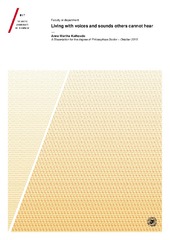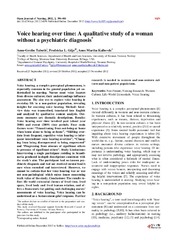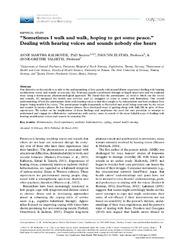| dc.contributor.advisor | Talseth, Anne-Grethe | |
| dc.contributor.author | Kalhovde, Anne Martha | |
| dc.date.accessioned | 2016-04-05T11:44:03Z | |
| dc.date.available | 2016-04-05T11:44:03Z | |
| dc.date.issued | 2016-03-31 | |
| dc.description.abstract | Hearing voices and sounds unshared by others, often termed auditory (verbal) hallucinations, is commonly known as a symptom of serious mental illness. The fact that it is not uncommon in the general population has led to research focused on hearing voices and sounds as experiences in themselves. The aim of this research project was to understand how people experience hearing and dealing with voices and sounds in everyday life and over time. One person without a psychiatric diagnosis and fourteen people with a psychotic illness participated in two to three in-depth interviews. These were mainly analyzed and interpreted with a hermeneutic phenomenological approach.
The results revealed that the woman without a psychiatric diagnosis had much in common with the participants who had a psychotic disorder; they all found living with hearing voices and sounds to be recurrently upsetting. Her daily life was, however, less frequently disrupted and she did not have to deal with other mental complaints or mental health services. The participants were recurrently struck by the experiences of hearing someone; this echoed and amplified past and present experiences with others and existential magnitudes. The participants developed ways of dealing with the opposing presences and the adversity they reflected through personal trajectories: some were linear, most were circular or spiraling. Central themes encompassed: retrieving or developing their sense of having a voice and navigating health care. Being believed by someone whom the participants trusted and could talk to about their experiences was essential to becoming more confident and developing new ways of understanding and dealing with the troublesome presences.
The results challenge nurses and other health care providers to engage in participatory dialogues and thus acknowledge voice hearer’s experiences and attune their interventions and aims to the voice hearer’s perspectives. Furthermore they are challenged to address past, present and future concerns or existential matters echoed by the voices (e.g. trauma, employment or meaningful activities, spiritual and religious matters). | en_US |
| dc.description.doctoraltype | ph.d. | en_US |
| dc.description.popularabstract | Å leve med stemmer og lydar som andre ikkje høyrer
Personar som høyrer stemmer og lydar forstår som regel at andre ikkje høyrer dei.
Stemmeerfaringane verka vere ekko av erfaringar med andre personar og eksistensielle
forhold som t.d. frykt for framtida og manglande håp.
15 personar har delteke i djup-intervju om deira kvardagserfaringar med å høyre stemmer
og lydar som andre ikkje høyrer. 14 hadde ei psykoseliding og hadde motteke psykisk
helsehjelp. Ei byrja høyre stemmer då ho vart ramma av sorg, utan å utvikle ei psykisk liding
eller behov for psykisk helsehjelp. Deltakarane hadde mellom 2-39 års erfaring med
stemmehøyring.
Deltakarane erfarte stort sett stemmene og lydane som påtrengande nærvær av nokon og
dette avbraut stadig daglege gjeremål og svevn. Mange utvikla seg over tid frå å vere redde
og forsøke å blokkera stemmene til det å prøve å forstå nærværa og akseptere dei. Å utvikle
eller finne si eiga stemme i høve til nærværa og andre, inkludert helsevesenet, verka vere
viktig. Nokre opplevde nærværa som gode eller hjelpsame, dei gav nyttige korrigeringar
eller håp i situasjonar der støttande andre var fråverande. For å bli tryggare på, og utvikle
nye måtar å halde seg til stemmene og lydane, var det avgjerande at deltakarane vart trudd
av nokon dei hadde tillit til og kunne snakke med om stemmene, lydane og forholda dei talte
om. Fleire opplevde også at det å gjere noko med forholda stemmene talte om, fekk
stemmene til minka eller forsvinne.
Anne Martha Kalhovde, Tlf 51776950/37, anne.martha.kalhovde@ihelse.net | en_US |
| dc.description.sponsorship | Helse Nord, Helse Vest, Jæren DPS | en_US |
| dc.description | Paper II of this thesis is as published version not available in Munin, but available in <a href=http://dx.doi.org/10.1177/1049732313507502> Qualitative Health Research 23(11) 1470–1480</a><br>The accepted manuscript version is available in Munin: <a href=http://hdl.handle.net/10037/9127> Kalhovde, Elstad, and Talseth (2013) Understanding the experiences of hearing
voices and sounds others do not hear.</a> | en_US |
| dc.identifier.uri | https://hdl.handle.net/10037/9098 | |
| dc.identifier.urn | URN:NBN:no-uit_munin_8679 | |
| dc.language.iso | eng | en_US |
| dc.publisher | UiT The Arctic University of Norway | en_US |
| dc.publisher | UiT Norges arktiske universitet | en_US |
| dc.rights.accessRights | openAccess | |
| dc.rights.holder | Copyright 2016 The Author(s) | |
| dc.rights.uri | https://creativecommons.org/licenses/by-nc-sa/3.0 | en_US |
| dc.rights | Attribution-NonCommercial-ShareAlike 3.0 Unported (CC BY-NC-SA 3.0) | en_US |
| dc.subject | sjukepleie | en_US |
| dc.subject | nursing | en_US |
| dc.subject | VDP::Medisinske Fag: 700::Helsefag: 800 | en_US |
| dc.subject | VDP::Medical disciplines: 700::Health sciences: 800 | en_US |
| dc.subject | VDP::Medisinske Fag: 700::Helsefag: 800::Sykepleievitenskap: 808 | en_US |
| dc.subject | VDP::Medical disciplines: 700::Health sciences: 800::Nursing science: 808 | en_US |
| dc.title | Living with voices and sounds other cannot hear | en_US |
| dc.type | Doctoral thesis | en_US |
| dc.type | Doktorgradsavhandling | en_US |


 English
English norsk
norsk


